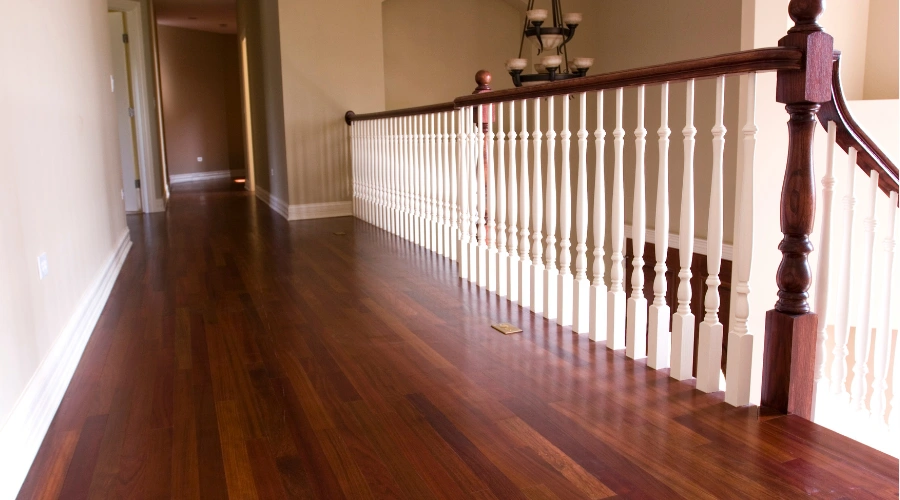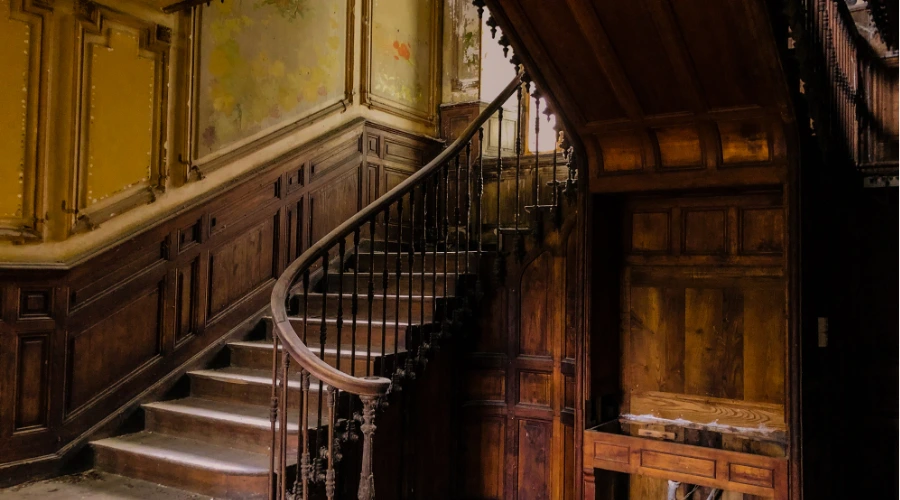Wood railings have stood the test of time for good reason. These practical safety features double as striking design elements in homes across India. At Brick & Bolt, we have installed various types over the years in construction, from simple pine bannisters to elaborate mahogany masterpieces. Each wood brings its own character while offering that natural warmth that synthetic materials just can’t match. With proper installation and occasional sealing, they’ll serve your family beautifully for decades.
Why Choose Wooden Railings?
Wooden railings bring both safety and style to your outdoor spaces and stairways. Feel protected on your deck, patio, or steps with these natural wood barriers that come in all kinds of looks – from traditional spindles to modern glass panels and sleek cable systems.
Beyond just keeping you safe, these wooden guards add character and warmth to your home. They give you something solid to hold onto when going up or down, making your home both beautiful and practical for everyone who lives there.
What Material is Used for Wood Railings?
They consist of components like posts, tops, and bottom rails, and infill materials such as balusters or spindles. Various kinds of wood can be used to make different materials. They are as follows:
Hardwood

Hardwood varieties commonly utilized in producing wood railings include mahogany, cherry, maple, and oak. They are naturally stunning and are most durable and endure long. They can be enhanced with a coating different stain, or paint. For example,
- Oak is ideal for heavily used areas as it boasts a Janka hardness rating of around 1,290 lbf (pound-force) and is highly resistant to wear.
- Mahogany offers durability and sophistication with its deep colour and impeccable finish, and its Janka hardness measures between 800 and 900 lbf.
Softwood

Softwood varieties commonly employed in making wood railings consist of cedar, pine, and redwood. When compared to hardwood, these woods are easy to use and work with. You can use this to decorate your interiors. These can also be available in various hues or paints. For instance,
- Cedar is a popular material for outdoor use, cedar contains a Janka hardness of about 350 lbf and possesses natural oils that repel rotting.
- Pine is cheap and easy to cut, but requires regular maintenance. Its Janka hardness varies between 380 to 870 lbf depending on the type.
Composite Materials
These materials are popular for use in railing. They effectively blend wood fibres and plastic to create weather-resistant alternatives that won’t rot or attract insects. As an alternative to wood railings, they come in many colours and styles to suit any home.
Metal
These elements are often matched with wood and give a modern, mixed-material look. Visual interest and strength can be added with their popular metal finishes, including black, bronze, and stainless steel.
Wooden Railing Design Ideas
- Classical Vertical Spindles
Wood balusters, when vertical, are a classic choice that lends a clean, structured look to both traditional and contemporary spaces. They complement most house styles and are easy to care for.
- Horizontal Wooden Slats
These wooden slats have a clean, open feel with an elegant look that creates more space. The design is especially popular for making minimalist interior designs.
- Carved Wooden Panels
Wooden panels with carvings provide an artistic touch and provide rooms with personality and artistry. They can be a focal point in your home and are a beautiful reflection of Indian history.
- Wood and Glass Mix Panels
A great design that freely allows light to enter and makes a space feel roomy is created by pairing glass inserts with hardwood frames. It’s best for homes that want a combination of modern design and warmth.
- Rustic Log Railings
This style incorporates a rustic touch by using natural logs or branches, and it’s perfect for cottages or homes that want to feel warm and nature-inspired. Since every piece is unique, the space is more unprocessed and natural.
Pros of Wood Railings
Several benefits of using wood railings for your space are as follows:
- Wood railings make rooms feel warm and nice.
- They can look rustic, like in a cabin, or fancy, like in a high-end home.
- The kind of wood you choose, whether it’s oak, teak, pine, or walnut, along with the type of finish applied, such as matte, glossy, or stained, can greatly impact the overall appearance and feel of your home.
- You can change the look of wood railings as you want.
- Every type of wood has its own look and colour.
- You may use a lathe to shape it, add colour with stain, paint it any colour to fit your interior decor, or carve designs into it.
- Wood comes from trees that can be regrown.
- Many wood sellers now get their wood from forests where new trees are planted after others are cut down.
- Utilizing wood is better for the planet than using materials that can’t be replaced.
Cons of Wood Railings
Even though it has some benefits, some limitations of using wood railings are as follows:
- Wood railings require some maintenance to keep them looking good.
- You will have to stain or seal them every few years to preserve the wood.
- Wood fences can be damaged even within your residence.
- Utmost care is required for them; if not, they will get ruined, scratched, or even invaded by insects.
- The type of wood used determines the cost of wood railings. Pine is one of the less expensive woods.
How to Install Wood Railings?
Installing wood railings isn’t overly complicated. Here’s a simple approach:
- Measure carefully and mark the exact spots for your posts. Precise measurements now prevent headaches later.
- Mount the posts securely using appropriate hardware. For deck posts, use galvanized lag screws and ensure they connect to solid framing. For stair posts, brackets often work best when properly anchored.
- Mount the top and bottom rails between posts. Use a level to ensure they’re perfectly horizontal—even slight mistakes will be apparent.
- Mount the balusters (spindles) between the rails. Space them according to local building codes—usually less than 4 inches apart to keep children from getting wedged.
- Sand everything thoroughly, from coarse to fine grit, for a smooth finish that resists splinters.
- Seal, stain, or paint with a quality product. It is wise to prime first for more durable adhesion and result longevity. Apply at least two coats for effective protection.
- Provide enough time between and before use for drying—hastening this process can destroy your finish.
- Always consult local building codes before beginning, since railing height and baluster spacing requirements differ geographically.
Cost of Wood Railings
The table below shows the cost of different types of wood railings. This may vary according to the location, the type of wood you are going to use, and design requirements.
| S.no | Wood Type | Cost (INR) per Linear Foot | Durability | Maintenance |
| 1 | Pine | ₹830 – ₹1,660 | Moderate (10-15 years) | Needs regular sealing & protection from insects and rot |
| 2 | Cedar | ₹1,245 – ₹2,490 | High (15-25 years) | Naturally resists rot & insects but benefits from occasional staining |
| 3 | Redwood | ₹2,075 – ₹4,150 | High (20-30 years) | Low maintenance, but staining helps retain colour |
| 4 | Mahogany | ₹4,150 – ₹8,300 | Very High (30+ years) | Needs periodic sealing to maintain its rich colour & durability |
How Do You Protect Wood Railings?
Wood railings should be installed with a moisture content between 10%–14% to reduce the risk of warping or cracking. Prolonged sun exposure causes lignin degradation, leading to greying and surface cracking. Use UV-resistant sealants to protect the wood.
Look for IS 401 treatment certification in treated wood to ensure resistance against rot and termite attack. Care is important. Clean the railings regularly and apply a fresh coat of sealant when needed. This simple maintenance prevents damage, keeps the wood from rotting, and makes the railings strong for years.
Conclusion
Wood railings add character to any home. They can transform your spaces completely. Different woods have distinct personalities. Cedar has been a good choice for outdoor projects since it naturally fights off moisture. Pine won’t break the bank, but it requires more upkeep.
Oak railings are rock-solid and stand for nearly 15 years. Worth the extra money if you’ve high foot traffic. Maintenance is simple. Just give a sanding and reseal every couple of years, which takes a weekend at most. Brick & Bolt is famous for its custom railings – our craftsmanship stands out when compared to other builders in the market.

